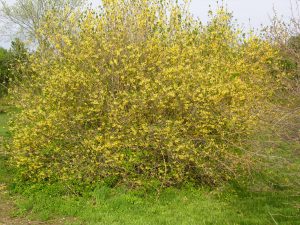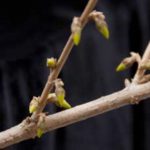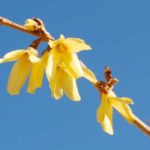Forsythia Fact Sheet

Forsythia is a deciduous shrub with upward and arching shoots that may be 10 feet tall and 15 feet wide. Forsythia is a popular cultivated plant that is used often in landscapes. Native to China, you can find forsythia throughout much of the northeastern US and Canada.
Flowers and Leaves: Small yellow flowers with four petals are produced on the old wood of the plant in the early spring. Like other plants that bloom in early spring, forsythia set their flower buds the previous year, and the buds overwinter. Flower buds are separate from leaf buds, and the flower buds open first. Flowers last about two weeks. As they start to fade, the leaf buds begin to open. Forsythia leaves are pointed, and have toothed edges.
|
|
|
Fruit: The fruit of a plant is the structure that contains seeds. The fruit of the forsythia are called “capsules,” which are dry fruits that split open into two or more chambers that hold seeds. Forsythia capsules fruits are hard, dry, brown capsules structures that split open into two chambers. Fruits develop from pollinated flowers, so look where flowers were in the spring.
Tips for Observing: Signs of the Seasons data sheets list leaves before flowers, but remember that flowers appear before leaves on forsythia! Make sure you record your observations in the correct section: Leaves or Flowers.
Sources and Additional Information:
USDA, NRCS. 2012. The PLANTS Database (http://plants.usda.gov, 20 May 2012). National Plant Data Team, Greensboro, NC 27401-‐4901 USA.
USA Phenology Network – Observing Plants and Animals, http://www.usanpn.org/Forsythia_spp



